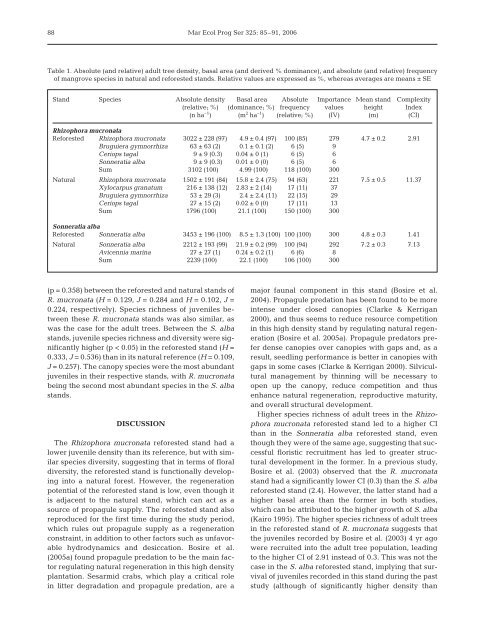Success rates of recruited tree species and their contribution to the ...
Success rates of recruited tree species and their contribution to the ...
Success rates of recruited tree species and their contribution to the ...
You also want an ePaper? Increase the reach of your titles
YUMPU automatically turns print PDFs into web optimized ePapers that Google loves.
88Mar Ecol Prog Ser 325: 85–91, 2006Table 1. Absolute (<strong>and</strong> relative) adult <strong>tree</strong> density, basal area (<strong>and</strong> derived % dominance), <strong>and</strong> absolute (<strong>and</strong> relative) frequency<strong>of</strong> mangrove <strong>species</strong> in natural <strong>and</strong> reforested st<strong>and</strong>s. Relative values are expressed as %, whereas averages are means ± SESt<strong>and</strong> Species Absolute density Basal area Absolute Importance Mean st<strong>and</strong> Complexity(relative; %) (dominance; %) frequency values height Index(n ha –1 ) (m 2 ha –1 ) (relative; %) (IV) (m) (CI)Rhizophora mucronataReforested Rhizophora mucronata 3022 ± 228 (97) 4.9 ± 0.4 (97) 100 (85) 279 4.7 ± 0.2 2.91Bruguiera gymnorrhiza 63 ± 63 (2) 0.1 ± 0.1 (2) 6 (5) 9Ceriops tagal 9 ± 9 (0.3) 0.04 ± 0 (1) 6 (5) 6Sonneratia alba 9 ± 9 (0.3) 0.01 ± 0 (0) 6 (5) 6Sum 3102 (100) 4.99 (100) 118 (100) 300Natural Rhizophora mucronata 1502 ± 191 (84) 15.8 ± 2.4 (75) 94 (63) 221 7.5 ± 0.5 11.37Xylocarpus granatum 216 ± 138 (12) 2.83 ± 2 (14) 17 (11) 37Bruguiera gymnorrhiza 53 ± 29 (3) 2.4 ± 2.4 (11) 22 (15) 29Ceriops tagal 27 ± 15 (2) 0.02 ± 0 (0) 17 (11) 13Sum 1796 (100) 21.1 (100) 150 (100) 300Sonneratia albaReforested Sonneratia alba 3453 ± 196 (100) 8.5 ± 1.3 (100) 100 (100) 300 4.8 ± 0.3 1.41Natural Sonneratia alba 2212 ± 193 (99) 21.9 ± 0.2 (99) 100 (94) 292 7.2 ± 0.3 7.13Avicennia marina 27 ± 27 (1) 0.24 ± 0.2 (1) 6 (6) 8Sum 2239 (100) 22.1 (100) 106 (100) 300(p = 0.358) between <strong>the</strong> reforested <strong>and</strong> natural st<strong>and</strong>s <strong>of</strong>R. mucronata (H = 0.129, J = 0.284 <strong>and</strong> H = 0.102, J =0.224, respectively). Species richness <strong>of</strong> juveniles between<strong>the</strong>se R. mucronata st<strong>and</strong>s was also similar, aswas <strong>the</strong> case for <strong>the</strong> adult <strong>tree</strong>s. Between <strong>the</strong> S. albast<strong>and</strong>s, juvenile <strong>species</strong> richness <strong>and</strong> diversity were significantlyhigher (p < 0.05) in <strong>the</strong> reforested st<strong>and</strong> (H =0.333, J = 0.536) than in its natural reference (H = 0.109,J = 0.257). The canopy <strong>species</strong> were <strong>the</strong> most abundantjuveniles in <strong><strong>the</strong>ir</strong> respective st<strong>and</strong>s, with R. mucronatabeing <strong>the</strong> second most abundant <strong>species</strong> in <strong>the</strong> S. albast<strong>and</strong>s.DISCUSSIONThe Rhizophora mucronata reforested st<strong>and</strong> had alower juvenile density than its reference, but with similar<strong>species</strong> diversity, suggesting that in terms <strong>of</strong> floraldiversity, <strong>the</strong> reforested st<strong>and</strong> is functionally developingin<strong>to</strong> a natural forest. However, <strong>the</strong> regenerationpotential <strong>of</strong> <strong>the</strong> reforested st<strong>and</strong> is low, even though itis adjacent <strong>to</strong> <strong>the</strong> natural st<strong>and</strong>, which can act as asource <strong>of</strong> propagule supply. The reforested st<strong>and</strong> alsoreproduced for <strong>the</strong> first time during <strong>the</strong> study period,which rules out propagule supply as a regenerationconstraint, in addition <strong>to</strong> o<strong>the</strong>r fac<strong>to</strong>rs such as unfavorablehydrodynamics <strong>and</strong> desiccation. Bosire et al.(2005a) found propagule predation <strong>to</strong> be <strong>the</strong> main fac<strong>to</strong>rregulating natural regeneration in this high densityplantation. Sesarmid crabs, which play a critical rolein litter degradation <strong>and</strong> propagule predation, are amajor faunal component in this st<strong>and</strong> (Bosire et al.2004). Propagule predation has been found <strong>to</strong> be moreintense under closed canopies (Clarke & Kerrigan2000), <strong>and</strong> thus seems <strong>to</strong> reduce resource competitionin this high density st<strong>and</strong> by regulating natural regeneration(Bosire et al. 2005a). Propagule preda<strong>to</strong>rs preferdense canopies over canopies with gaps <strong>and</strong>, as aresult, seedling performance is better in canopies withgaps in some cases (Clarke & Kerrigan 2000). Silviculturalmanagement by thinning will be necessary <strong>to</strong>open up <strong>the</strong> canopy, reduce competition <strong>and</strong> thusenhance natural regeneration, reproductive maturity,<strong>and</strong> overall structural development.Higher <strong>species</strong> richness <strong>of</strong> adult <strong>tree</strong>s in <strong>the</strong> Rhizophoramucronata reforested st<strong>and</strong> led <strong>to</strong> a higher CIthan in <strong>the</strong> Sonneratia alba reforested st<strong>and</strong>, eventhough <strong>the</strong>y were <strong>of</strong> <strong>the</strong> same age, suggesting that successfulfloristic recruitment has led <strong>to</strong> greater structuraldevelopment in <strong>the</strong> former. In a previous study,Bosire et al. (2003) observed that <strong>the</strong> R. mucronatast<strong>and</strong> had a significantly lower CI (0.3) than <strong>the</strong> S. albareforested st<strong>and</strong> (2.4). However, <strong>the</strong> latter st<strong>and</strong> had ahigher basal area than <strong>the</strong> former in both studies,which can be attributed <strong>to</strong> <strong>the</strong> higher growth <strong>of</strong> S. alba(Kairo 1995). The higher <strong>species</strong> richness <strong>of</strong> adult <strong>tree</strong>sin <strong>the</strong> reforested st<strong>and</strong> <strong>of</strong> R. mucronata suggests that<strong>the</strong> juveniles recorded by Bosire et al. (2003) 4 yr agowere <strong>recruited</strong> in<strong>to</strong> <strong>the</strong> adult <strong>tree</strong> population, leading<strong>to</strong> <strong>the</strong> higher CI <strong>of</strong> 2.91 instead <strong>of</strong> 0.3. This was not <strong>the</strong>case in <strong>the</strong> S. alba reforested st<strong>and</strong>, implying that survival<strong>of</strong> juveniles recorded in this st<strong>and</strong> during <strong>the</strong> paststudy (although <strong>of</strong> significantly higher density than
















